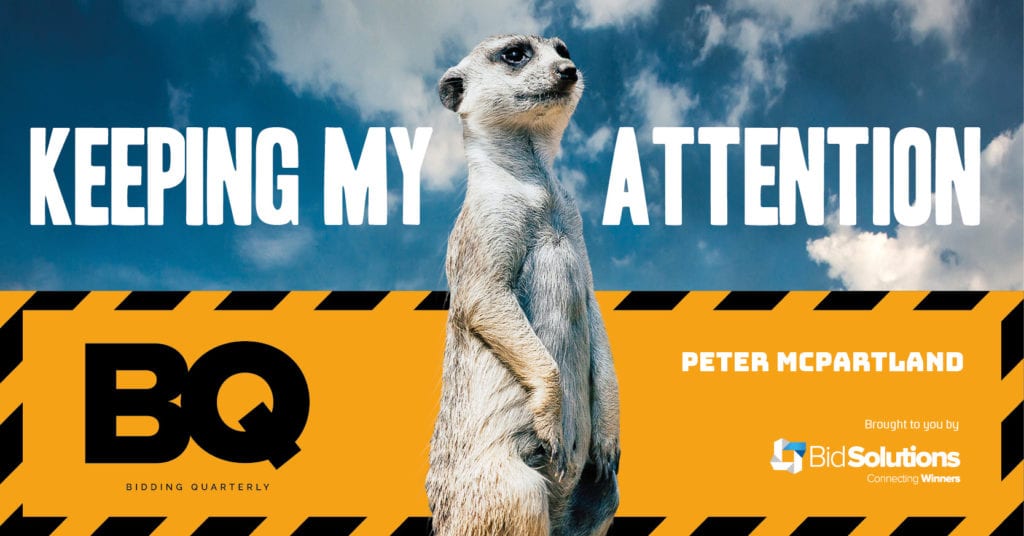
A year of home working – for many, not just the few – has emphasised a trend that I’ve been mindful of for many years. Long gone are the days that our bid responses are scrutinised in detail by teams of evaluators concentrating on print outs of our in-depth answers, page by page.
What this means is that more than ever before we need to find ways to bring our bids to life for the reader if they are to maintain concentration when reviewing our bids.
Glued to our screens
A surge in screen time during lockdown saw adults in the UK glued to their devices for more than 40% of the waking day, according to 2020 research by industry watchdog Ofcom. In its annual study of the nation’s media habits, Ofcom found adults in the UK spent an average of 45 hours in front of screens time each week – computers, mobiles and TV. That figure is often reaching 70 hours for desk-based workers who are no longer commuting to an office.
Alarmingly, our screen time rose by almost 33% compared to the 2019 figure, as lockdown forced people to stay indoors for months on end. As lockdowns continue, it is expected to rise even further.
Our increased screen time reinforces the reality that today, there are very few of us not programmed to expect instantaneous access to information, goods, services and people. It doesn’t matter what generation we would traditionally pigeon-hole audiences into based on their age. We constantly flit between applications and devices. Online meetings have even given rise to attendees engaging in meetings whilst tapping away on their keyboard and checking their mobiles. Incredible advances in mobile connectivity continue to drive our expectations of immediacy and variety even further.
The fact is that our core DNA has been reprogrammed to reduce our motivation to spend time performing research or analysing information.
Why lockdown life has killed our attention span
Added to the above is a realisation that lockdown life has meant people’s ability to concentrate for long periods of time has been challenged like never before. Covid-19 has forced us to replace face-to-face engagement with online experiences. We jump from one virtual meeting to another. We are suffering visual fatigue from prolonged exposure to a screen. Opportunities for scheduled ‘switch-off’ time in our commutes and social catch-ups have gone. Our mental-wellbeing has also been affected as anxieties about how we will personally exist in a post-lockdown world are pricked by the media.
Our audiences are bombarded by distractions every day
Lifestyles that demand quick satisfaction and constant connectivity make it increasingly difficult to hold readers’ attention as they perform more reactive and simultaneous behaviours than ever before. In a well-publicised study by Microsoft, performed in the middle of the last decade, they concluded that the human attention span had dropped to eight seconds, shrinking nearly 25% since the start of the century. This figure is only going one way and the gap between ourselves and the humble goldfish, linked with a figure of nine seconds, will certainly grow.
Bringing our bids to life
It’s critical that our bid response and content is engaging, authoritative and thought-provoking. It needs to constantly stimulate through creativity, variety and focus. Here are some reminders:
- Very few bids will ever be printed and so should be landscape (not portrait) to fit to the screen
- Executive Summaries are more important than ever before. They should be aligned to a best practice format to ensure they are focussed, logical and have impact.
- A clear and simplified document structure will enable the reader to progress confidently. You should build interactivity throughout the document to streamline navigation and introduce different media. Website designers use a ‘three-clicks to anywhere/from anywhere’ principle.
- Less written content, strong visuals, facts and figures all enable the reviewer to move through the document at a quicker pace. Review and replace traditional paragraphs with diagrams. Highlight evidence through infographics and client quotes. See white space as an important part of your layout.
- Emphasise the client throughout the response using images they can relate to. Accentuate details you know about them beyond simply their company name.
- Break pages up with headlines. Ask yourselves, “If these headlines were online, would they be compelling enough to be clicked on?”
- Avoid applying rigid layout styles across every page as they foster monotony
- Use videos to drive engagement and create a more memorable experience. Research shows that viewers retain 95% of a message when they watch it in a video, compared to 10% when reading it in text.
- Highlight metrics that are important to the client, clearly demonstrating what the measurable impact of working with you will be
- Paragraphs of text will always form parts of your bid. Ensure you commit enough time to carry out copy-smoothing to remove ambiguity, repetition and duplication in your copy.
Lockdowns, and the effects of an increasingly digitalised lifestyle on the brain, mean we must work harder than ever before to help bid reviewers maintain concentration when reviewing our bids.
This article was written by Peter McPartland.
Peter is recognised for his strengths in bid team leadership, innovation and performance improvement. One of the first law firm employees to achieve the APMP Certified Professional qualification, Peter is also a winner of an APMP UK national award for Innovation.

